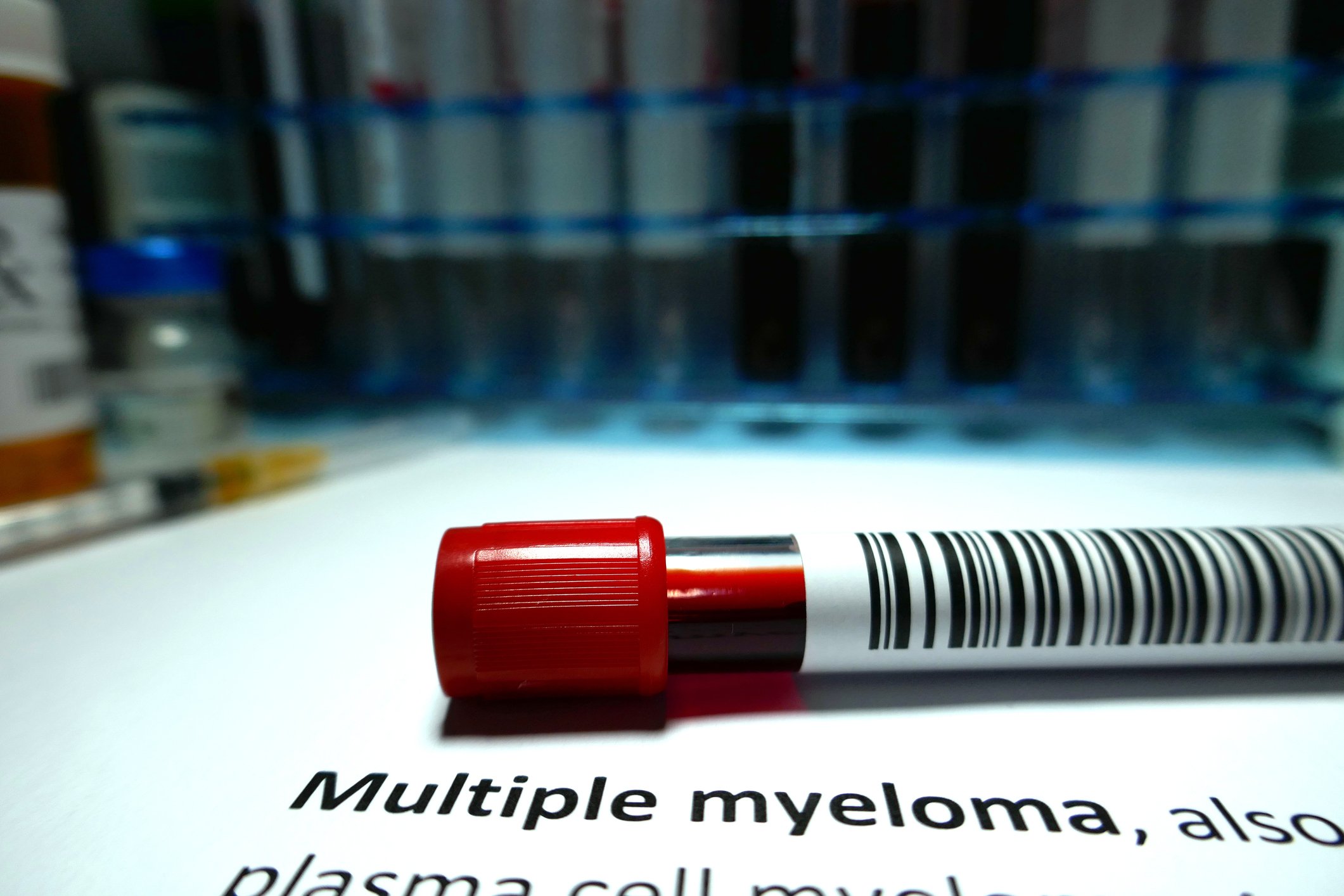A report on the Multiple Myeloma Ireland Patient and Carer Day 2020, which took place virtually this year
It may have taken place via the medium of Zoom, but the 2020 Multiple Myeloma Ireland Patient and Carer Information Day was no less valuable in terms of helpful advice and education for patients with the blood cancer.
The close-knit community of patients, supporters and healthcare professionals made the most of the virtual gathering, with an array of topical presentations on offer throughout the day.
Dr Niamh Keane, a Consultant Haematologist at Galway University Hospital, opened the meeting by giving an overview of the condition, explaining its biology, the clinical features of multiple myeloma, and the range of management options available.
Multiple myeloma is a neoplastic disease characterised by clonal proliferation of malignant plasma cells in the bone marrow. This leads to a wide range of manifestations, and CRAB is the acronym for the most common symptoms of multiple myeloma – elevated Calcium, Renal failure, Anaemia, or Bone problems.
Understandably, an extensive whole body assessment is needed in order to definitively diagnose the disease – this includes blood and urine tests to check for abnormal antibodies or paraproteins, as well as kidney damage, plus bone marrow biopsies and imaging such as MRI and/or PET scanning to assess bone damage. “For many patients, up to one-fifth, the presenting symptoms can be simply tiredness, which is very non-specific,” noted Dr Keane.
She outlined the spectrum of bone marrow disease that can precede multiple myeloma, such as monoclonal gammopathy of undetermined significance (MGUS) and smouldering myeloma; neither of these conditions display symptoms and so do not require treatment, but patients will need to be monitored as there is potential to progress to symptomatic multiple myeloma.
The principles of therapy in multiple myeloma are to stop the production of abnormal plasma cells, strengthen the bone and prevent fractures, treat anaemia and reduce fatigue, as well as ensuring quality-of-life by tailoring the treatment to the patient.
Dr Keane explained that as a disease that affects multiple organ types, it often requires the input of several different specialists, such as haematologists, oncologists, orthopaedic surgeons, etc.
“Every patient is different and support needs to be tailored to the individual patients.” Supportive and preventive care are essential to derive maximum benefit from the latest advances in treatment but the good news is that the whole suite of multiple myeloma care options is continually improving.
Dr Keane concluded on a positive note: “Patients are living longer than ever with multiple myeloma in 2020.”
Psychological stress
Sorcha Connellan, a senior clinical psychologist at University Hospital Limerick then delivered a presentation on coping skills for those with multiple myeloma. Outlining the psychological and emotional responses to multiple myeloma, Ms Connellan noted that stress is a natural response to feeling threatened. Once the diagnosis of multiple myeloma is made, the most common responses are fear, sadness and anger, she explained.
Patients can get stuck in an unhelpful pattern of thinking, expecting the worst, or just noticing the things they can’t do. She suggested using tools like meditation, yoga, and mindfulness at times when people feel overwhelmed with fear and anger.
Low mood can be lifted via an upregulating activity such as exercise. She urged patients to keep a sense of perspective; “accept the things you cannot change and change the things you can, take control.” Multiple Myeloma Ireland support groups are invaluable for patients, as well as the Irish Cancer Society and local cancer support centres.
The process of stem cell transplant for myeloma was outlined by Karen Mulhall, a clinical nurse specialist in haematology at Galway University Hospital. She outlined the basis of the procedure, as well as the many practical issues involved for patients. Prior to the procedure, significant work-up is required, including pulmonary function tests, an echocardiogram, a dental assessment, and a skeletal survey, among other tests.
The procedure itself takes roughly five-to-six hours and side effects usually begin few days later; this includes significant mouth soreness, as well as gut irritation, which can cause nausea and diarrhoea. Fatigue is also common, and this can persist throughout the recovery period.
Exercise
Miriam Flatley, a senior physiotherapist at Galway University Hospital with a special interest in haematological disorders, presented on the importance of exercise and movement for multiple myeloma. Ms Flatley outlined the myriad health benefits of exercise on general wellbeing, but also noted that in recent years there is a growing body of evidence to suggest that it is of significant benefit for patients with cancer.
“As well as being effective, exercise is also very safe for you to take, before, during, and after your cancer treatment.” She acknowledged, however, that fitness levels can be affected by the disease as well as the treatments the patient is undergoing, emphasising the importance of including physical activity into the management plan.
Exercise can help prevent functional decline, and will also help to strengthen bones, hugely important in the context of multiple myeloma, explained Ms Flatley. It also improves fatigue, a common symptom of the disease and can help to alleviate the side effects of some treatments. Patients should not exercise when they are feeling nauseous, if their blood count is low, or if they have an infection and/or fever, she noted.
Covid-19
Covid-19 and multiple myeloma was the topic of the talk delivered by Geraldine Walpole, an advanced nurse practitioner at Sligo University Hospital. She explained how treatment had been adapted or adjusted for different cohorts of multiple myeloma patients.
Although treatment is being postponed in some situations due to Covid risk, Ms Walpole explained that for the young transplant-eligible patients, treatment should not be postponed and therapeutic decisions should be made on a case by case basis. Granulocyte-colony stimulating factor (G-CSF) support would also be considered in order to avoid neutropaenia.
For some patients on continuous first-line treatment, however, consideration should be given to delaying the autologous stem cell transplant (ASCT) and instead prolong the induction regimen for up to six-to-eight cycles.
“This will be at the discretion of your consultant as we know transplant is a very immunocompromising event and we have to tread very carefully,” she explained, adding that patients who are scheduled to undergo transplant should be tested for Covid-19 as a precaution beforehand.
Phone and virtual visits are being used to great effect to monitor the patients on maintenance treatment, in order to decrease clinic attendance and thus reduce risk even further, Ms Walpole said. Patients who are stable should also be minimising their visits to the hospital, and community services have been invaluable during this time, she added.
Some supportive treatments may be delayed, but again this is on an individual basis.
“The usual precautions that everyone is using for Covid-19 also apply to you and I would suggest that you should be wearing face coverings every time you leave your house,” she concluded.
Treatment strategies
‘Current Developments in Managing Multiple Myeloma’ was the title of the concluding presentation, delivered by Dr Siobhan Glavey, a Consultant Haematologist at Beaumont Hospital, Dublin. She used the time to outline the various options involved in the treatment of multiple myeloma, the push towards individualised therapy, as well as some of the novel therapies that have recently become available.
Latest data indicates that the incidence of myeloma has increased by 126 per cent from 1990 to 2016, noted Dr Glavey; “this is likely due to increased incidence of cancers worldwide, but also due to better diagnostics”. She pointed out that Ireland is among the countries with the top incidence rates of multiple myeloma, with an incidence here of somewhere between five and six per 100,000.
The importance of cytogenetics was highlighted, with Dr Glavey explaining that by understanding the genetics of the myeloma cells, this may indicate more about the biological signature of the disease in each patient. “This could be the most important tool in multiple myeloma to predict outcomes,” she advised.
Nowadays, treatment is tailored to the patient in order to maximise the benefit of the treatment while minimising toxicity or side effects; “there is no one size fits all.” Shared decision-making between healthcare professionals and patients is key, she added.
The natural course of multiple myeloma typically involves an asymptomatic phase before patients develop symptoms and require treatment. Dr Glavey explained that induction treatment is required once this happens and the aim of this phase is to get the patient into a complete remission using first-line available therapies and possibly a stem cell transplant based on their age and performance status.
“Unfortunately, we know that the vast majority of these patients will eventually relapse and in that case will require additional therapy, fortunately we have a wide range of therapies now available to patients, both in the frontline and relapsed refractory settings,” she said.
Thalidomide was approved in 2008, followed by bortezomib and lenalidomide in their various doublet and triplet combinations and then came the next generation drugs like pomalidomide and carfilzomib. Several new classes of drugs are also now available, including the monoclonal antibodies daratumumab and elotuzumab and also some novel histone deacetylase (HDAC) inhibitors.
“New mechanisms of action have markedly expanded the treatment options for multiple myeloma,” said Dr Glavey. Despite these advances, however, stem cell transplant remains the most effective therapy in eligible patients, providing the “best chance of deep and durable remission”, said Dr Glavey, noting however that there are significant associated side effects, including the risk of infection, as well as the associated psychological distress.
The next exciting novel therapy in myeloma is cellular therapy, Dr Glavey concluded.
“To-date this has been in the form of CAR-T cells, but other cell types are also showing remarkable results,” she told the online audience. Irish patients will be partaking in European Myeloma Network trials in the near future, she added.
See multiplemyelomaireland.org/ for more information on the work of MMI Ireland













Leave a Reply
You must be logged in to post a comment.